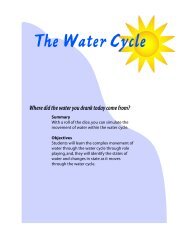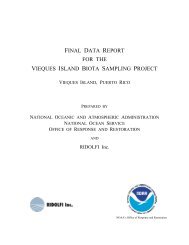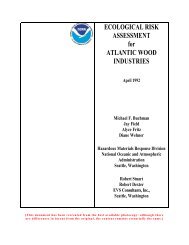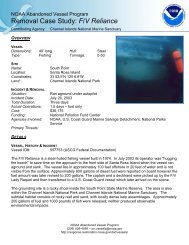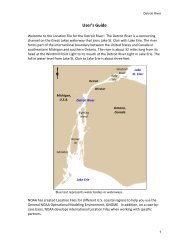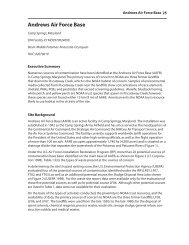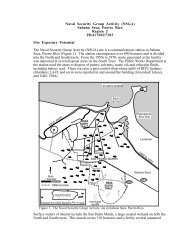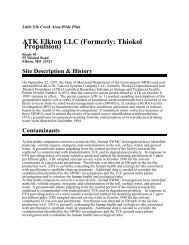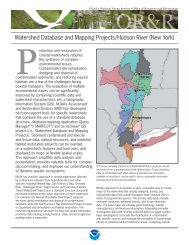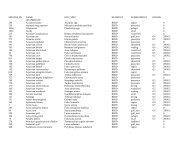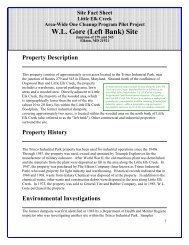Puget Sound Naval Shipyard - NOAA's Ocean Service Office of ...
Puget Sound Naval Shipyard - NOAA's Ocean Service Office of ...
Puget Sound Naval Shipyard - NOAA's Ocean Service Office of ...
- No tags were found...
Create successful ePaper yourself
Turn your PDF publications into a flip-book with our unique Google optimized e-Paper software.
108 • Region 10the Washington State Department <strong>of</strong> Fisheries,surf smelt spawn in the intertidal zone <strong>of</strong> thesouthern section <strong>of</strong> Sinclair Inlet and use bothSinclair Inlet and nearby Dyes Inlet as nurseryhabitat (Zichke personal communication 1991).Herring may spawn near PSNS. Numerousspecies <strong>of</strong> demersal fish, including Pacific hake,Dover sole, ling cod, and starry flounder, plusvarious species <strong>of</strong> perch, rockfish, and sculpin useSinclair Inlet for seasonal nursery and adult foragehabitat. These species may also congregate nearthe piers and pilings <strong>of</strong> PSNS.Broad intertidal flats and bars provide excellentspawning and nursery substrate for molluscs.Littleneck, Manila, butter, and horse clams areabundant over most intertidal areas, particularlynear Gorst Creek. Sea cucumbers are also abundantin Sinclair Inlet (Fyfe personal communication1991). Oyster and adult crab populationsare small. Dungeness crab, rock crab, and kelpcrab tend to congregate near Rich Passage (Figure2). Squid may drift seasonally into SinclairInlet and spawn (Zichke personal communication1991).Fish and shellfish fisheries in Sinclair Inlet arelimited. Commercially harvested salmon make upthe majority <strong>of</strong> landings from Sinclair Inlet.Substantial Suquamish Tribe effort is directedtowards salmonid runs in the vicinity <strong>of</strong> SinclairInlet. Most fishing occurs in Port Orchard<strong>Sound</strong> above Illahee or in Sinclair Inlet (Figure2). Three principal salmon fisheries occur annuallyon stocks <strong>of</strong> Sinclair Inlet origin: an August-September fall chinook tribal gillnet fishery, whichtargets returning enhanced chinook from theGorst Creek rearing facility; the fall treaty andnon-treaty harvest <strong>of</strong> chum salmon; and the falltreaty and non-treaty harvest <strong>of</strong> coho salmon(Zichke personal communication 1992). Smallcatches <strong>of</strong> smelt and perch also occur.Recreational fishing effort in Sinclair Inlet isreported to be light, although catch data were notavailable. Summer steelhead and cutthroat troutfishing occurs in most streams which discharge tothe inlet (Freymond personal communication1991). In areas <strong>of</strong>f the Bremerton shoreline andin Port Washington Narrows (Figure 2), there isusually moderate sport fishing for salmon fromSeptember to late November. The water aroundRoss Point (Figure 2) supports a recreational surfsmelt fishery (Brooks personal communication1992; WDF 1992). The sandy southern shore <strong>of</strong>Sinclair Inlet supports a regular demersal sportfishery targeting Pacific cod, starry flounder, andseveral species <strong>of</strong> sole (WDNR 1977). There isinfrequent sport crabbing for Dungeness crab<strong>of</strong>fshore in Port Orchard <strong>Sound</strong> (Zichke personalcommunication 1992).The commercial harvest <strong>of</strong> bivalves from SinclairInlet has never been certified and is now prohibitedby the Washington State Department <strong>of</strong>Health because <strong>of</strong> high fecal coliform counts(Melvin personal communication 1991; Noshopersonal communication 1991). Although thisprohibition does not <strong>of</strong>ficially extend to all recreationalharvests, the Bremerton-Kitsap County108 • Coastal Hazardous Waste Site Review / <strong>Puget</strong> <strong>Sound</strong> <strong>Naval</strong> <strong>Shipyard</strong>



